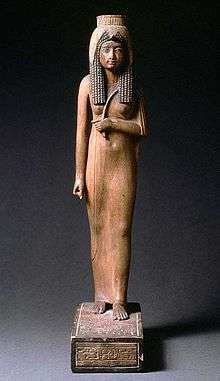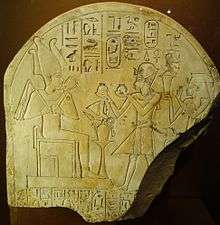Ahmose-Nefertari
| Ahmose-Nefertari in hieroglyphs | ||||||||||||
|---|---|---|---|---|---|---|---|---|---|---|---|---|
| ||||||||||||
| Ahmose-Nefertari | |||||
|---|---|---|---|---|---|
|
Queen consort of Egypt Great Royal Wife God's Wife of Amun Regent | |||||
|
Ahmose Nefertari as depicted in tomb TT359 | |||||
| Born | 1562 BC | ||||
| Died | 1495 BC | ||||
| Spouse | Pharaoh Ahmose I | ||||
| Issue |
Amenhotep I, Ahmose-ankh , Prince Siamun , Ramose ? Ahmose-Meritamun, Mutnofret ?, Ahmose-Sitamun | ||||
| |||||
| Dynasty | 18th of Egypt | ||||
| Father | Pharaoh Tao the Brave | ||||
| Mother | Queen Ahhotep I | ||||
| Religion | Ancient Egyptian religion | ||||
Ahmose-Nefertari of Ancient Egypt was the first Queen of the 18th Dynasty. She was a daughter of Seqenenre Tao and Ahhotep I, and royal sister and the great royal wife of pharaoh, Ahmose I. She was the mother of king Amenhotep I and may have served as his regent when he was young. Ahmose-Nefertari was deified after her death.
Family

Ahmose-Nefertari was a daughter of Seqenenre Tao and Ahhotep I and the granddaughter of Senakhtenre and queen Tetisheri.[1] Ahmose-Nefertari was born in Thebes, likely during the reign of Senakhtenre Ahmose (not Tao—as this king's nomen has now been discovered to be 'Ahmose' like that of his grandson Ahmose I).[2][3] She grew up with quite a few brothers and sisters including the princes Ahmose, Ahmose-Sipair and Binpu, and the princesses Ahmose-Henutemipet, Ahmose-Tumerisy, Ahmose-Nebetta, Ahmose-Meritamon, as well as her half-sisters Ahmose-Henuttamehu, Ahmose and Ahmose-Sitkamose.[1]
Ahmose-Nefertari may have married Pharaoh Kamose, but if so there is no record of such a marriage.[2] She did become the great royal wife of pharaoh, Ahmose I. With Ahmose she had at least three sons. She is depicted on a stela from Karnak with a son named Ahmose-ankh, a son named Siamun was reburied in the royal cache DB320, but it was her son Amenhotep I who would eventually succeed his father to the throne. She was the mother of queen Ahmose-Meritamun and Ahmose-Sitamun. She may also have been the mother of Mutnofret, the wife of Thutmose I. A prince named Ramose included among the Lords of the West and known from a statue now in Liverpool, may be another son of Ahmose-Nefertari.[1]
Life

Ahmose-Nefertari was born during the latter part of the seventeenth dynasty, during the reign of her grandfather Senakhtenre Ahmose.[2] Her father Seqenenre Tao fought against the Hyksos and may have lost his life during a battle. He was succeeded by Kamose.[1] It is possible that Ahmose-Nefertari married Kamose, but no evidence exists of such a marriage.[2]
After the death of Kamose the throne went to Ahmose I. Pharaoh Ahmose was very young and queen-mother Ahhotep I served as regent during the early years of his reign. Ahhotep would have taken precedence at court over her daughter Ahmose-Nefertari, who was the great royal wife. Ahmose I became the first king of the eighteenth dynasty, a pharaoh ruling over a reunited country.[2]
Queen Ahmose-Nefertari held many titles, including those of hereditary princess (iryt-p`t), great of grace (wrt-im3t), great of praises (wrt-hzwt), king’s mother (mwt-niswt), great king’s wife (hmt-niswt-wrt), god’s wife (hmt-ntr), united with the white crown (khnmt-nfr-hdjt), king’s daughter (s3t-niswt), and king’s sister (snt-niswt).[4] The queen was revered as "Goddess of Resurrection" and was arguably the most venerated women in Egyptian history.[5]
A donation stela from Karnak records how king Ahmose purchased the office of Second Prophet of Amun and endowed the position with land, goods and administrators. The endowment was given to Ahmose-Nefertari and her descendants. Separately the position of Divine adoratrix was also given to Ahmose-Nefertari.[6] Records from a later era indicate that in this position she would have been responsible for all temple properties, administration of estates, workshops, treasuries and all the associated administration staff.[7]
Amenhotep I came to power while he was still young. As his mother, Ahmose-Nefertari, may have served as regent for him until he reached maturity.[6][8]
Ahmose-Nefertari is shown to be alive during the early years of the reign of Tuthmosis I. She is depicted in Nubia by the Viceroy of Kush Ahmose called Turo in the company of the newly crowned king and Queen Ahmose. A vase fragment found in KV20 was inscribed with the double cartouche of king Tuthmosis I and Ahmose-Nefertari and the epithet indicates the queen was alive. A large statue of queen Ahmose-Nefertari from Karnak may be one of the last statues created in her honor before she died.[9]
Death and Burial
Ahmose-Nefertari likely died in approximately the fifth or sixth year of Thutmose I. Her death is recorded on the stela of a wab-priest called Nefer. The text mentions that “the divine consort Ahmose-Nefertari, justified with the great god lord of the West, flew to heaven". Helck proposed that the annual cult holiday (II Shemu 14) dedicated to Ahmose-Nefertari at Deir el-Medina may have commemorated the day of her death. The father of Nefer, who was likely none other that the overseer of the royal works Ineni, oversaw her burial.[9]
She was likely buried in Dra Abu el-Naga, and had a mortuary temple there. Her mummy is assumed to have been retrieved from her tomb at the end of the New Kingdom and moved to the royal cache in DB320. Her presumed body, with no identification marks, was discovered in the 19th century and unwrapped in 1885 by Emile Brugsch but this identification has been challenged.[10] The mummy emitted such a bad odor that Brugsch had it reburied on museum grounds in Cairo until the offensive smell abated. Ahmose-Nefertari died in her 70s. Her hair had been thinning and plaits of false hair had been woven in with her own to cover this up. Her body had been damaged in antiquity and was missing her right hand.[6]
Deification and worship
The villagers of Deir el-Medina held Amenhotep I and his mother Queen Ahmose Nefertari in high regard over many generations.[8] When Amenhotep died he became the center of a village funerary cult, worshiped as "Amenhotep of the Town". When the Queen died she also was deified and became "Mistress of the Sky" and "Lady of the West".[6][11]
| Wikimedia Commons has media related to Ahmose-Nefertari. |
References
- 1 2 3 4 Dodson, Aidan and Hilton, Dyan. The Complete Royal Families of Ancient Egypt. Thames & Hudson. 2004. ISBN 0-500-05128-3
- 1 2 3 4 5 Forbes, Dennis C. Imperial Lives: Illustrated Biographies of Significant New Kingdom Egyptians. KMT Communications, Inc. 1998. ISBN 1-879388-08-1
- ↑ Sébastien Biston-Moulin, "Le roi Sénakht-en-Rê Ahmès de la XVIIe dynastie", ENIM 5, pp.61-71, 22 mars/march 2012 [online:
- ↑ Grajetzki, Ancient Egyptian Queens: A Hieroglyphic Dictionary, Golden House Publications, London, 2005, ISBN 978-0-9547218-9-3
- ↑ The Woman in Black, Graciela Gestoso Singer University & Heritage - Unesco World Heritage Centre
- 1 2 3 4 Tyldesley, Joyce. Chronicle of the Queens of Egypt. Thames & Hudson. 2006. ISBN 0-500-05145-3
- ↑ "The Great Goddesses of Egypt", Barbara S. Lesko, p. 246, University of Oklahoma Press, 1999, ISBN 0-8061-3202-7
- 1 2 Shaw, Ian. The Oxford History of Ancient Egypt. Oxford University Press. 2000. ISBN 0-19-280458-8
- 1 2 Louise Bradbury, Nefer's Inscription: On the Death Date of Queen Ahmose-Nefertary and the Deed Found Pleasing to the King, Journal of the American Research Center in Egypt, Vol. 22 (1985), pp. 73-95
- ↑ The so-called Royal Cachette TT 320 was not the grave of Ahmose Nefertari
- ↑ Tyldesley, Joyce (1996). "Hatchespsut: The Female Pharaoh", p62, Viking, ISBN 0-670-85976-1.
External links
- Ahmose Nefertari Image of her coffin and short bio.
- Mummy of Ahmose-Nefertari by Max Miller.
- "Women in ancient Egypt"
- "The Glory and Power"
- "Women in Power BCE 4500-1000"
- "Royal Women"
- Hatshepsut: from Queen to Pharaoh, an exhibition catalog from The Metropolitan Museum of Art (fully available online as PDF), which contains material on Ahmose-Nefertari (see index)